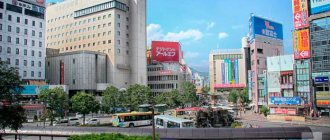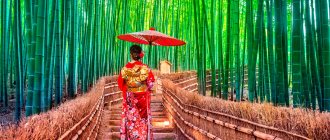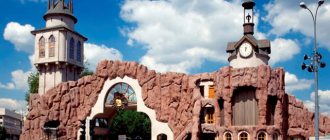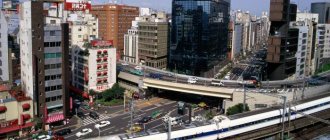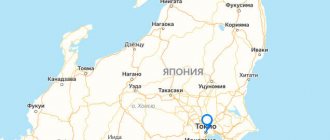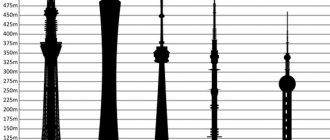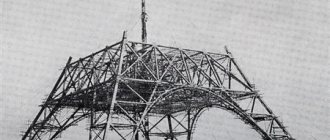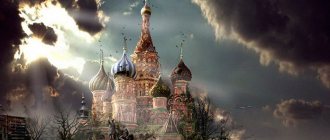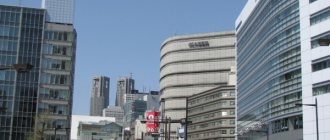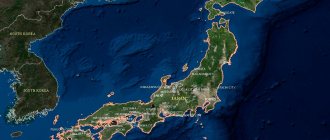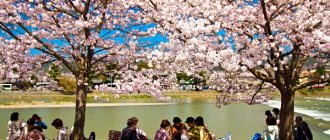Location and boundaries. Square.
Also on topic:
JAPAN
Located in the southeastern part of the Pacific coast of the island of Honshu, on the Kanto Plain, at the confluence of the Edogawa, Arakawa, Sumida, and Tama rivers into Tokyo Bay. Tokyo Metropolitan Prefecture (Greater Tokyo) is a highly urbanized area with a total area of 2187 square meters. km. Its administrative boundaries include Tokyo itself (615.8 sq. km, 23 administrative districts), 26 other cities, 24 urban or rural villages (located including on the islands of Izu and Ogasawara). The capital prefecture and the adjacent prefectures of Kanagawa, Chiba, Saitama form the so-called Tokyo metropolitan area, or the Metropolitan area (Shutoken). Together with Yokohama, it forms the world's largest metropolis, Tokyo-Yokohama.
Living in Tokyo is so convenient that you can get to the places you need in just a couple of minutes.
Tokyo residents can get to anywhere from grocery stores to work and even Michelin-starred sushi restaurants in just a few minutes - the city's infrastructure is so developed.
It is also worth noting that the majority of non-public Tokyo companies are ranked among the world's largest companies. Thus, Tokyo is one of the three major cities-centers of global economic management.
Transport hubs. Airports.
Tokyo is the main transport hub of the country. High-speed railway lines and expressways converge on it, for which overpasses with complex multi-level interchanges are laid through densely built areas. The port of Tokyo is one of the most important centers of maritime transport (in terms of trade turnover, it is the second in Japan after Yokohama). Tokyo has two airports, but they are among the largest and most modern in the world. Narita Airport is located 80 km northeast of Tokyo and accepts international flights. Haneda Airport is located on the shores of Tokyo Bay, 14 km from the city center, and specializes in domestic transportation. Both airports are connected by rail to Main Station in central Tokyo. Shinkansen high-speed trains and express trains on the Tokaido Line (Nagoya, Kyoto, Kobe, Osaka, Hiroshima, Kyushu Island) arrive at this station. Trains on the Tohoku Line (Sendai and Morioka) arrive at Ueno Station, north of Tokyo Main Station. Trains from Niigata also arrive here. Trains to the Japanese Alps (Matsumoto) depart from Shinjuku Station. Rail services also play an important role in connecting various parts of the Tokyo metropolis, which is penetrated by an extensive network of subway lines, elevated trains and monorails. More than 25 million people use the transport system every day. Each train line in Tokyo has its own color. The Yamanote Line (green or silver with green stripes) is a 35 km ring around the central part of the city. The train makes a circle in an hour, passing 29 stops, including important transport hubs of the city (Yurakucho, Shinbashi, Shinagawa, Hibiya, Shinjuku, Ueno). The Chuo Line - orange - runs from east to west Tokyo to the suburb of Takao. During the day, trains pass through the city center almost without stopping. The city center is served by the Sobu Line (yellow). The Keihin Tohoku Line (blue) runs from the north (Omiya area in Saitama Prefecture) to the south (Ofuna area in Kanagawa Prefecture).
Tokyo
Tokyo is a fairly young city, only 400 years old. During its relatively short history, it changed its name, managed to survive devastating earthquakes, many fires, as well as the war that gave its name to the historical era.
Greater Tokyo is a huge metropolis that has merged with neighboring Kawasaki and Yokohama. With all this, it can be argued that Tokyo in Japan has become a city of contrasts, where European culture is combined with Eastern culture, antiquity with modernity, and the concrete jungle with temples.
Location
The city of Tokyo is located in the Land of the Rising Sun, in the southeastern part of the island of Honshu, in the Kanto region, on the shores of Tokyo Bay in the Pacific Ocean. Tokyo Prefecture is the largest economic, political, financial and cultural center of the country. The city includes 23 districts, as well as the Tama region, the islands of Izu, Ogasawara and several other small islands. The area of Tokyo is 2187 square meters. km.
City `s history
The chronicle of Tokyo dates back to the 12th century, when the first fort was built here. At the end of the 16th century, Tokyo, then called Edo, which means “mouth of the river,” became the capital of the shogunate. With the beginning of the Meiji era after the overthrow of the Tokugawa shogunate, the city again acquired capital status, and with it received its current name, which translated means “eastern capital”.
In the 20th century, Tokyo was almost completely destroyed twice. First, in 1923, there was a strong earthquake followed by a fire, which destroyed many monuments of the Edo era and claimed the lives of 140 thousand people. During World War II, the city suffered greatly from air raids. After the end of hostilities, gradual restoration and active development of the capital began.
Nowadays, history and modernity are surprisingly intertwined in the Japanese capital. Tokyo's population is more than 13.5 million people, and tens of thousands of tourists come here every year.
Climate in Tokyo
The city is located in the humid tropics, so summer is characterized by hot weather and high humidity. In winter it is usually comfortably dry and... The rainy season occurs at the end of June - mid-July. Spring lasts from March to May, the weather is generally favorable, with occasional warm rains. Tokyo sees a lot of tourists during this period.
It is warmest in June-August, and when the rainy season ends, the air temperature reaches +30°C. September to November are the autumn months in Tokyo. In September it is still very warm, but in October there are typhoons. Winter comes in December. It’s surprising that there can be snow in the city center, and at the same time the thermometers near the Ogasawara Islands show +20°C.
Nature
Rivers such as Sumida, Tama, Arakawa, and Edogawa flow through Tokyo. On the northern and western sides, the capital is surrounded by mountains. Tokyo has some wonderful gardens and parks that are works of art, such as Hibiya Park.
Districts of Tokyo
The urban districts in Tokyo are very diverse and colorful, each with its own unique atmosphere:
- the most prestigious quarter of the capital is Ginza
, it is home to many fashionable hotels, boutiques and restaurants; - The main business center in Tokyo is considered Marunouchi
, and the largest is
Shinjuku
; - Shibuya
district attracts fans of pop culture and youth movements, and
the Ueno
is a huge public park, which houses the Museums of Western Art, Science, the Tokyo National Museum, the City Art Gallery, the Royal Ueno Museum and the country's most famous zoo; - Kamakura
district will be of interest primarily to lovers of antiquity and religion; there are many shrines and temples here; - It is also worth mentioning the most unusual district of Tokyo - Odaiba
, which is an artificial island with unusual architecture and interesting museums.
What to visit in Tokyo?
It all depends on the time you have to explore the huge metropolis. The most important attractions of the Japanese capital Tokyo:
- Imperial Garden and Tokyo Palace.
The complex is located in the heart of Tokyo. The first buildings appeared in the 16th century. The castle grounds are now divided into two parts. The western part is closed to visitors; the Imperial Palace is located here, and the private chambers of the imperial family are located in the Fukiage Garden. The Eastern Garden of the palace is located in the eastern part. The few buildings that remain from Edo Castle are declared national treasures of Japan and are protected by the state. - Tokyo Tower.
The Tokyo Tower is a symbol of the city, just like the Eiffel Tower for the French. In 1958, when it was built, it was the tallest in the world. From 2 observation platforms there is an amazing view of Tokyo Bay and the entire city. - Roppongi Hills.
There are shops, offices of large companies, many restaurants, a cinema, a Hyatt hotel, a television studio, and a concert venue. On the 52nd floor there is the best observation deck in Tokyo, where you can look at the city from a bird's eye view. - Happo-en Garden.
Your Tokyo itinerary should include a visit to the tea ceremony, which is held at a table or on a tatami and lasts 20 minutes. - Omote-sando and Harajuku areas.
Interesting places in Tokyo are located on Omote-sando street. They are also called the local Champs Elysees. This is a center of fashion and design and, of course, a favorite hangout for Japanese youth. In this area there is a temple named after Meizi, who is greatly revered by the Japanese. - Shinjuku skyscraper district.
The new Tokyo City Hall building is located in the Shinjuku skyscraper district. Having climbed to the 45th floor, you will find yourself on the observation deck. - Buddhist temple Asakusa.
This is one of the most ancient Buddhist temples in Tokyo. Along Nakamise Street, leading to the temple, there is a brisk trade in amulets and souvenirs, so it’s worth going here to buy gifts for your family and friends. - Thirteen bridges of the Sumidagawa River.
Pleasure steamers regularly cruise along the Sumidagawa River. Each bridge across the river has its own story, which each guide will tell you in detail. - The man-made island of Odaiba.
On an island in the middle of Tokyo Bay you will find showrooms of famous companies Toyota and Panasonic. From the island of Odaiba there is a magnificent view of the night, illuminated city and the beautiful Rainbow Bridge. This panorama is one of the most popular photos of Tokyo. - DisneySea.
Disney Sea and Disneyland are no less interesting attractions in Tokyo. These are popular amusement parks based on fairy tales and cartoons. Here you will plunge into the world of pirates, mermaids, and sail on a submarine with Captain Nemo.
Where else to visit in Tokyo?
On the second and subsequent days of your stay in Tokyo, you should see museums (for example, the Samurai Sword Museum), the stock exchange, wonderful Japanese-style gardens (Hamarikyu, Rikugien, Koraku-en), the Ginza storefront, sumo wrestling competitions, judo training in Kodokan Hall. In a word, you definitely won’t get bored here, and your trip to Tokyo will be remembered for the rest of your life.
Hotels and restaurants
You will find a huge number of hotels in the capital of Japan, from the most modest 2* level to luxurious 5* luxury hotels. The cost of a room in a 2-3* hotel averages from $150 to $250. There are many such hotels in the Shinjuku area: Hotel Kadoya, Hotel Listel Shinjuku, Hotel Park Inn Shinjuku. In addition to European-level hotels, there are traditional ryokans in Japan.
Speaking about restaurants and cafes in Tokyo, the first thing I would like to note is the Ginza gastronomic district, where establishments are suitable for the most sophisticated gourmets. The most popular sushi restaurants include the 3-Michelin-starred Sukiyabashi Jiro restaurant, as well as Sushi Mizutani and Sushi Araki. In addition to premium restaurants, Ginza has a large number of budget establishments with traditional Japanese cuisine, as well as restaurants offering Italian, French, Chinese, Korean, Indian cuisine and even American fast food.
Purchases
We associate Japan with cars, appliances, cosmetics, designer clothes, pearls, kimonos and other goods. Tokyo is the shopping capital of the world; here you can find products of very high quality and at reasonable prices. There are several retail outlets in the city where you can buy strictly defined goods. For example, Ochanomizu is worth a trip to buy musical instruments, Akihabara has a huge selection of electronics, and Kanda has books in different languages. If you want to buy clothes, cosmetics or jewelry, you can go to the Ginza Street area of Kyoto or to the suburb of Minami Machida, located 40 minutes from the capital. The shops in the Shibuya area are perfect for young people.
Tips for tourists
For tourists in Tokyo, there is an information center at Yurakucho Station, where you can go to find the necessary information, including hotel rooms. The center is open daily from 9:00 to 17:00.
Follow simple rules during your trip: no handshakes, bow when greeting, do not smoke in public places, do not leave tips for anyone and always arrive on time, the Japanese are very punctual.
Transport Tokyo
Several of the most modern highways converge in the Japanese capital, three high-speed rail lines originate here, there is a subway, land trains, a seaport and two major international airports (Narita and Haneda). The Tokyo subway is the busiest in the world, with over 3 billion people using its services every year. It has 13 lines and 274 stations. The minimum fare is 170 yen ($1.5).
How to get to Tokyo?
From Moscow to Tokyo you can take a direct flight to Narita International Airport, located an hour by high-speed train from the city center. Narita is Tokyo's new airport and serves the majority of international flights. The flight cost starts from $300, and the flight duration is 9-10 hours.
Story.
The city owes its original name to the fishing village of Edo (Japanese for “entrance to the bay”). In 1457, Ota Dokan, the ruler of the Kanto region, built Edo Castle here. In 1590, Ieyasu Tokugawa, the founder of the powerful shogun dynasty, took possession of it. Although Kyoto remained the capital of the empire, Edo became the seat of the Tokugawa, and in the 18th century. – one of the largest and most populated cities in the world. After the Meiji restoration (“revolution”), Emperor Matsuhito moved his capital here (1868), giving the city its current name - Tokyo - “Eastern Capital”. In the second half of the 19th century. The silk, lacquer, earthenware and enamel industries actively developed here, and from the end of the 19th century. – mechanical engineering and shipbuilding. The Tokyo-Yokohama railway was built in 1872, and the Kobe-Osaka-Tokyo railway was built in 1877. On September 1, 1923, Tokyo experienced a terrible earthquake (7.9 on the Richter scale), which wiped out half the city from the face of the earth. More than 90 thousand people became its victims. A reconstruction plan was soon adopted. The city began to rise from the ruins. But during the Second World War it again suffered catastrophic destruction. In the middle of the 20th century. The country's economy began to rapidly revive (an "economic miracle"), and in 1966 it reached second place (after America's) in the world. In 1964, the city successfully hosted the Summer Olympic Games. The strong influx of labor from rural areas (1970s) created one of the most important preconditions for growth. In the 80s, Tokyo was one of the most dynamically developing cities in the world.
People
Japan is renowned for its culture of harmony , and the Asian country is seemingly one of the most polite societies in the world. Habits and social etiquette are of great importance here, and the extreme politeness of the people will likely make a strong impression on you. In Tokyo, it is not uncommon to see craftsmen bowing down to greet you at an underground passage, or shopkeepers bowing incessantly as you exit a store after making a purchase.
Industry.
Until the 1960s, many manufacturing enterprises were concentrated in Tokyo. Currently, most of them are located outside the city limits. Management, trade and distribution, and scientific and information areas play an increasingly important role in the economic life of the city. The head offices of the largest financial and industrial companies (Mitsui, Mitsubishi, Sumimoto, etc.), other private, semi-state and government groups, major banks (Bank of Japan, Development Bank, Import-Export Bank, Central Bank of Japan, etc.) are located in Tokyo. , as well as representative offices of foreign monopolies. Most of the administrative institutions are located in the Marunouchi, Otemachi, and Nihonbashi areas. Tokyo is one of the most important financial centers in the world. In terms of the volume of financial transactions, the Tokyo Stock Exchange is comparable to the famous stock exchanges of New York and London. Greater Tokyo remains the center of one of the largest industrial urban areas (Keihin), which accounts for 22% of the country's industrial output. A significant part of Japan's mechanical engineering is concentrated here. Mechanical engineering and metalworking specialize in the production of complex and precision machines, instruments, electrical and electronic equipment and apparatus, optical-mechanical products, automobile and aircraft construction, shipbuilding, production of railway equipment and rolling stock, machine tool building, road engineering and other types of mechanical engineering. Metallurgy is developed. The chemical industry is dominated by branches of fine chemical technology: production of medicines, cosmetic products, photochemicals, varnishes and paints, in particular printing ones; oil refining and petrochemistry (chemistry of fiber, plastics, etc.). A diverse food industry (brewing, flour milling, fish canning and many other industries), processing mainly imported raw materials. Numerous branches of light industry (textiles, clothing, leather, ceramics, furniture, jewelry, souvenirs, etc.). Most industrial enterprises are small and medium-sized with up to 300 employees. Industrial enterprises are located mostly along the banks of the river. Arakawa - in the areas of Koto, Johoku, Zenan, Kita, etc. In Tokyo proper, almost no new industrial construction is being carried out, mainly due to high land prices and the high cost of necessary measures to combat environmental pollution.
Metropolitan.
The history of the Tokyo metro begins on December 30, 1927: on this day, a private company, then called Tokyo Chika Tetsudo (Tokyo Underground Railway), opened the first subway line between the capital's Ueno and Asakusa stations with a length of only 2.2 km. Currently, Tokyo has 12 metro lines with a total length of more than 230 km. These branching lines cover the map of the capital in an intricate grid. Each line has its own color. Signs in two languages at the entrance to the station and trains are indicated by the color of their line. The Tokyo subway is built and operated by private companies and city governments; therefore, there are both private and municipal lines; Often, over fairly large segments, the lines run almost parallel to each other. Stations are equipped with many exits (at large stations there may be 15–20) and transitions. The metro is quite tightly integrated into the overall transport network of the capital. Within one station, by moving to another platform, you can transfer to a city train or even a long-distance train.
The Japanese also managed to do the impossible - solve the problem of traffic jams.
As part of a massive $11 billion , 30-year , the Tōkyō-wan-Aqua-Line, a unique combination of bridge and tunnel, was built in Tokyo. Thus, the journey, which took an hour and a half on the shore, was reduced to 15 minutes ! And the reason for such long work was the special strength of the road, which is resistant even to earthquakes.
Scientific institutions.
There are over 50 state, municipal and private universities and colleges in Tokyo, incl. such prestigious ones as the public University of Tokyo (“Tokyo Daigaku”, or “Todai” for short) or the private universities of Waseda and Keio. The Japanese Academy of Sciences, the Japanese Academy of Arts, over 100 research institutes, laboratories and centers at universities, about 40 at ministries and departments, including the National Aerospace Laboratory, the National Cancer Center, and the National Research Center for Disaster Protection are also located here. , research institutes of health care, hygiene, natural resources, population problems, etc. Largest libraries: National Parliamentary Library, university libraries.
Hayao Miyazaki and Studio Ghibli
Hayao Miyazaki is the godfather of Japanese animated films and a national treasure, the Japanese version of Walt Disney. Miyazaki is the co-founder of Studio Ghibli , founded in 1985. The animation studio has produced such high-grossing films as Spirited Away and Howl's Moving Castle. The studio also houses a museum, a carefully designed attraction to attract visitors. The museum (unsurprisingly, a Mecca for anime fans) was created by Miyazaki himself and has the motto: “Let's get lost together.”
Culture.
The city has 400 art galleries, as well as several dozen state, municipal and other museums, among which the most interesting are the Tokyo National Museum, the Edo-Tokyo History Museum, the Okura Shukokan Museum, the Nezu Museum, the National Science Museum, the National Museum of Western Art, and the National Museum of Modern Art. art, Bridgestone Museum, Museum of Folk Crafts, Museum of Calligraphy, Ota Museum with an exhibition of Japanese ukiyo-e prints, Sword Museum, Fuji Museum, Sumida River Museum. Among the small, sometimes unusual museums are the Museum of Glasses, the Museum of Lighters, the Museum of Bags, the Museum of Bicycles, and the Museum of Plumbing. Theatres: National Noh Theatre; National Theatre; New National Theatre; Kabukiza Theater; Engey Hall. Concert halls: “Ueno bunka kaikan”, “Nitigakijo” (for variety performances), “Kokusai gekijo”, “Koseinenkin kaikan”, “Toyoko horu”; the huge hall of the Japan Broadcasting Corporation (NHK), famous for classical music concerts.
Architecture.
Experienced in the 20th century. gigantic destruction and an “economic miracle” made Tokyo a testing ground for architectural experiments and determined its current futuristic appearance. It is formed by dozens of skyscrapers (administrative buildings and hotels), in the shadows of which there are narrow streets without names and miraculously preserved tiny houses. City blocks are united not by traditional axes, but by cumbersome multi-level overpasses that penetrate Tokyo in all directions. A rare example of an ancient architectural ensemble is the Asakusa quarter with its Sensoji temple complex, the main hall and pagoda of which are only copies of buildings destroyed in 1945 as a result of American bombing. The historical center is the Nihonbashi district, where the imperial palace is located surrounded by a park (built around 1600, rebuilt in the 19th and 20th centuries). In the style of most public buildings of the late 19th - early 20th centuries. imitation of Western models predominates (Akasaka Palace, 1909, architect O. Katayama; Parliament, 1915–1936, architect T. Ohama, etc.); however, since the 1910s, early examples of creative processing of local architectural traditions in the spirit of modern architecture also appeared (post office, 1934, architects T. Yoshida, M. Yamada). Preparations for the 1964 Olympic Games gave a powerful impetus to urban planning work. Modern highways were laid in residential areas, and numerous expressways were built on overpasses. In the 60–70s, new urban centers (Shinjuku, Ikebukuro, Tama) developed rapidly, where intensive high-rise and underground construction was carried out. The implementation of large-scale plans for the reconstruction and development of Tokyo did not change the general chaos of its architectural appearance. Among the notable buildings of the second half of the 20th century. – red 333-meter Tokyo Tower (1958); Metropolitan Festival Hall in Ueno Park (1960–1961, architect K. Maekawa); The Olympic Sports Complex (1963–1964), St. Mary's Cathedral (1964) and, finally, the tallest building in Tokyo - the 354-meter complex of the capital's administration City Hall (1991, architect K. Tange).
Tokyo is truly a city that is fully prepared for the future.
All countries will struggle with rising water levels due to the inevitable effects of global warming and declining resource extraction and manufacturing capabilities. But it seems that Tokyo is already ready for this.
The government takes into account the mistakes of the past and is gradually rebuilding the city, making it a more convenient and comfortable place for living, production and business development. And it's really impressive!
see also
Facts about Japan's fastest and slowest bullet trains
see also
The most unusual car designs from Japan
see also
Japanese sleeper trains of the 1960s: an inside look
Entertainment and shopping complexes.
Tokyo residents' favorite vacation spots are parks and squares, but their area is only about 5 thousand hectares. The most famous are the park in the area of the imperial palace, as well as the Hibiya, Meiji, and Ueno parks. Asakusa Park and its surrounding streets form the largest entertainment district in Tokyo. There are many restaurants, theaters, and souvenir shops here. Ginza is a “showcase” of Tokyo and all of Japan, a traditional shopping and cultural center with many department stores, cafes, restaurants, cinemas and other leisure facilities. Shinjuku is a historical entertainment district. It is currently built up with skyscrapers housing many nightclubs. Two stops from the Main Station is the computer pleasure district - Akihabara; shops selling household electrical appliances and electronics are concentrated here (products come to the shelves directly from factory conveyors, bypassing intermediaries). In 1983, Disneyland opened 10 km from the city center (48 hectares, 7 thematic zones), which is extremely popular.
Shinjuku Imperial Park
Shinjuku Imperial Park is probably the most beautiful place in Tokyo. Founded at the beginning of the 20th century, the park first belonged to the imperial family. Now access here is open to everyone. The amazing layout of the garden divides it into three parts.
A Japanese garden with a tea house sets the mood for contemplation. The English and French parts are reminiscent of Old World landscape finds. More than 10 thousand trees delight you with their blooms in spring; in summer you can’t take your eyes off the blooming hydrangeas and myrtle. In autumn, lilies and chrysanthemums bloom. The winter landscape makes you freeze in admiration, as if in front of a painting by a great master.
Toyota Mega Web Exhibition Center
The Toyota Mega Web Exhibition Center is one of the most interesting places in Tokyo, especially for car enthusiasts. It is located on Odaiba, in the Palette Town entertainment center.
The exhibition center tells about the history and development of the Japanese automobile industry. Entering the museum's vaults, visitors find themselves in the amazing world of cars, from the very first models that seem to have rolled off the assembly line yesterday to the latest developments. You can even ride on many models. The main part of the exhibition is focused on the history of the development of the Toyota brand. Not only well-known models are presented, but also those that did not go into production.
Rare cars occupy a separate room; exhibits in the following rooms tell about the features of the cars. Test drives for children and adults allow you to ride right through the pavilions.
Tourism.
Tokyo has first-class museums and entertainment complexes, a developed hotel industry, a modern transport system and offers its guests service that meets the highest world standards. However, Tokyo is the most expensive city in the world. This circumstance, as well as the language barrier, remain the main obstacles to the development of mass tourism. Although the number of foreign tourists visiting Tokyo is constantly increasing, its ratio to the number of local residents lags far behind that of the main tourist meccas.
Tokyo's infrastructure projects are truly admirable.
For example, Tokyo is implementing a hydrogen transport system as part of a $350 million project. It involves increasing the number of hydrogen stations from 8 to 35, as well as the launch of 6 thousand cars and 100 buses with hydrogen fuel cells.
New devices provide vehicles with greater mileage and reduced refueling time. And with the energy generated by just two of these buses, you can supply the entire hospital with electricity for the whole day. The Tokyo government is also considering cutting the number of roads in half.
Population.
The population of the Tokyo metropolitan area (Tokyo, Chiba, Funabashi, Kawasaki and Yokohama) reached 33 million people in 2003, incl. Greater Tokyo (metropolitan prefecture) - 12.4 million people (10% of Japan's population), of which the population of Tokyo proper is 8.35 million people. Age structure of the population: 11.9% – children under 14 years of age (inclusive); 70.9% – from 15 to 64 years old; 17.1% are 65 years of age and older. There is a steady trend towards an increase in the proportion of older people. The average population density of Tokyo is 800–1000 people per 1 sq. km. According to this indicator, the Japanese capital is among the five most densely populated cities on the planet. The number of foreigners registered in Tokyo also reached a historical high of 355,000, with the Chinese leading the way, followed by Koreans and Filipinos.
The Russian population of Tokyo is insignificant and does not play a special role in its life.
Sergey Karp
These Tokyoites are music lovers
In conclusion, I would like to tell you about one interesting fact, known only to music lovers and those associated with music. Many (if not all) musicians, when some creative and financial problems begin in their homeland, without any hesitation, pack their suitcases and equipment and go on tour to Japan. “Only in Tokyo am I accepted with open arms at any time of the year and under any circumstances,” once said the famous rock musician Michael Schenker, who once founded the legendary band “Scorpions” with his brother, and later became the frontman of the immortal “UFO” " “And only in Tokyo can I feel at home.”
For those who don’t believe, we advise you to look through the discography of all the popular musicians of the last decades - almost everyone has “live” albums with the titles “Made in Japan”, “Live in Tokyo”, “One night at Budokan” and other similar ones, or even not one album, and not two, but several at once.
